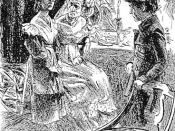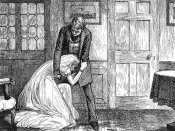One of the most important and common tools that authors use to illustrate the themes of their works is a character that undergoes several major changes throughout the story. In Great Expectations, Charles Dickens introduces the reader to many intriguing and memorable characters, including the eccentric recluse, Miss Havisham, the shrewd and careful lawyer, Mr. Jaggers, and the benevolent convict, Abel Magwitch. However, without a doubt, Great Expectations is the story of Pip and his initial dreams and resulting disappointments that eventually lead to him becoming a genuinely good man. The significant changes that Pip's character goes through are very important to one of the novel's many themes. Dickens uses Pip's deterioration from an innocent boy into an arrogant gentleman and his redemption as a good-natured person to illustrate the idea that unrealistic hopes and expectations can lead to undesirable traits.
In the beginning of the novel, Pip is characterized as a harmless, caring boy, who draws much sympathy from the reader even though he is at that point content with his common life.
The reader most likely develops warm and sympathetic feelings toward Pip after only the first two pages of the novel, which introduce the fact that Pip's parents are "dead and buried" and that the orphan has never seen "any likeness of either of them" (Charles Dickens, Great Expectations, New York, Penguin Putnam, Inc., 1998, p. 1). Pip's confrontation with the convict presents his harmless, innocent nature. As Magwitch first seizes the young boy, Pip simply responds, "Oh! Don't cut my throat, sir, ÃÂ Pray don't do it sir" (p. 2). Then, Pip is forced into submitting to the convict's demands, mainly due to his naive fear of Magwitch's fictitious companion who "has a secret way pecooliar to himself of getting at a boy, and at...


